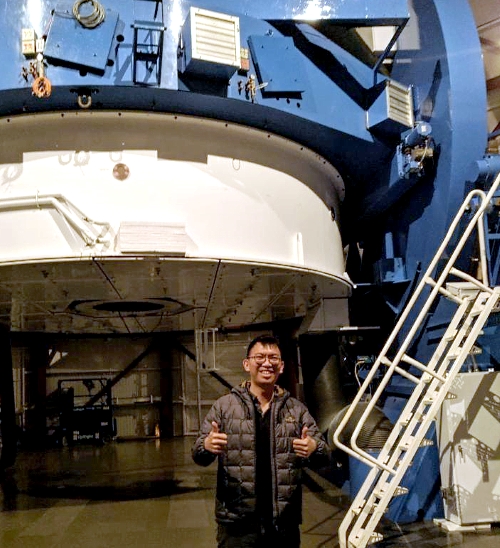By Yuan-Sen Ting
In 1994, a major earthquake in California triggered a blackout in Los Angeles. Anxious about staying indoors, people walked out of their houses in panic and looked up. They couldn't believe their eyes.
A local observatory reported a few residents called the neighboring observatory.
"Sir, please tell me, the silvery light across the sky, would that be a sign or a bad omen?"
The on-duty astrophysicist at the other end of the phone was utterly amused.
No, Sir, that's the Milky Way, the galaxy where our Sun is; it has always been there."

Have you ever imagined what the world looked like before we had electricity?
I am an astrophysicist. I study the galaxy where our Sun lives — the Milky Way. In a way, being an astrophysicist has an ironic dimension for me. I grew up in Kuala Lumpur in Malaysia, where the sky is always pitch black. Nothing appears. Even after returning to where I was born, in Sibu, I could only see a few of the brightest constellations very sporadically. When I told my friends back home that I study the night sky, they were often puzzled, "Really? What is out there to study?"
We tend to focus on the benefits of technology, and, more often than not, we ignore the costs.
No doubt, technology has done amazing things and has brought us the splendor of the city. But that splendor also has a black mirror. Technology has been advancing with such warp speed that it "velocitizes" our perception of time; it is hard for us to realize that there was no electric lighting merely 150 years ago. That is to say, for most of human history, it was the norm to see a brilliant star-filled sky. It was only during the last 100 years or so, that the night sky was engulfed by light pollution, blocking the starlight, and real darkness canopied the sky.
Oh well, as the old saying goes, when the gods close one door, another opens. But nowadays that newly opened door is much farther away, even though the real starry sky is still out there, somewhere.
Most astronomical telescopes are built in the most deserted places, forcing astronomers like me to muster my courage to make arduous trips. For instance, to travel from my home in Princeton, New Jersey (on the east coast of the United States) to the observatory in Chile, I have to take three flights and ride for more than two hours by jeep across the Atacama Desert.
Even so, everything seems more than worthwhile the instant I arrive and observe what the Milky Way has to offer.
I always wonder, the written record of human history only dates back to a few thousands of years. In the hundreds of thousands of years without words or even language, how many people have lived in a cave and looked at the same sky as we do? And how fortunate do I have to be to be in a time where we finally can understand what we see after all these years.
Following the footsteps of stars to unravel the Milky Way
Ancient Greek mythology recounts that the Milky Way is the breast milk of the goddess Hera, hence the name. But we now know that this Milky Way is less mythical milk, and is composed of our Sun and its neighboring stars.
It was long known to us that we are not singular. Our Sun is nothing but a normal star; about one trillion of such stars live in the Milky Way. This number is ten times greater than all the people who have ever existed on the earth (counting all your great- great-great-ancestors.) But not only is the number of stars staggering, but the size of the Milky Way is also mind-blowingly vast. The distance from one end of the Milky Way to the other is about 100,000 light-years.
That is to say, if we were to release a beam of light from one end of the Milky Way, this light will not arrive at the other end for another 100,000 years (recall that same beam of light can circle the earth 7.5 times in one second).
But wait, how do physicists know that? Well, while technology ruined the sky for most, it also provides many new perspectives of our reality that are otherwise unknown to us. In theory, it should not be too difficult to measure the "waistline" of our Galaxy as well as to weigh it. As an analogy, although we can't reach the Sun, the speed of the Earth and other planets is attracted by the gravity of the Sun. Therefore, as long as we can measure a planet's trajectory, we can easily infer the weight of the Sun. Similarly, since the movement of stars is affected by the gravity of the Milky Way, so long as the trajectory of stars can be measured, we can then infer and learn much about the Milky Way.
That said, measuring the precise movement of stars is a daunting task that many in the past have tried to do, but with no avail. When I was a kid, I loved to stare at the sky and watch planes streak slowly above. While the plane might appear to move at a snail’s pace, in reality, the planes’ speed is about ten times faster than the speed limit permitted on highways (except in Germany.) The apparent slowness is due mainly to the plane’s great distance from us. Even if the plane is moving at high speed, its movement across the sky is perceived as minuscule on Earth. And that is only for planes still bound to the Earth! What astrophysicists want to measure is the movement of stars that are thousands or even tens-of-thousands of light-years away from us!
Here comes the amazing Telescope
As Kennedy said, "We choose to go to the Moon in this decade and do the other things, not because they are easy, but because they are hard … because that challenge is one that we are willing to accept, one we are unwilling to postpone.."
To understand the Milky Way, the European Space Agency launched the amazing Gaia telescope in 2013. How amazing is it, you might ask? The Gaia telescope reaches a resolution that is equivalent to watching the movement of a single hair from few tens of kilometers away. And such precision is what allows us to detect the movement and distance of billions of stars, forever changing our understanding of the Milky Way.
Of course, Gaia is just the tip of the iceberg. We have many more other surveys that are collecting very different data from stars in the Milky Way. Nor is our interest in the Milky Way limited to studies as superficial as measuring the Galactic waistline. Research on the Milky Way has been booming in recent years, providing many new results. In our next column, we’ll discover some of these exciting new findings.
I live in Princeton, New Jersey, not too far from New York City. Here, like on most parts of the Earth, the Milky Way is invisible. Nevertheless, not seeing the Milky Way with my own eyes does not limit my research. After all, what modern astronomy is doing has long surpassed all our five senses or even our imagination.
Our technology bifurcates one sky into two. One is engulfed by light pollution, so dull and boring that most people will not even think of looking up. The other is the night sky beyond the five senses. And as an astrophysicist, I am honored to be allowed to tunnel between these two night skies.
(Yuan-Sen Ting is an astrophysicist. Yuan-Sen obtained his Ph.D. in astrophysics from Harvard University in 2017. He is currently a researcher working at the Institute for Advanced Study in Princeton, funded through a NASA Hubble Fellowship. Yuan-Sen is also an incoming faculty member at the Australian National University.)
ADVERTISEMENT
ADVERTISEMENT


































